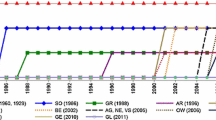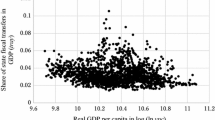Abstract
An analysis of the flypapereffect under different institutionalcontexts is carried out for Colombia,where during the decentralizationprocess different sub-national fiscalstructures with different degrees ofautonomy to manage transfers,expenditures, taxes and debt havecoexisted. The analysis is carried outby using panel data models andalternative functional forms. Theresults show that the flypaper effectis observed when sub-national entitiesare highly dependent onintergovernmental transfers. Ananalysis of asymmetries in response totransfers shows that sub-nationalauthorities try to cover the reductionin transfers when the percentage oftransfers into the total currentrevenue is high.
Similar content being viewed by others
References
Ahmad, E. and Baer, K. (1997). Colombia. In: T. Ter-Minassian (Ed.), Fiscal federalism in theory and practice, 457-485. International Monetary Fund.
Bahl, R. and Linn, J. (1994). Fiscal decentralization and intergovernmental transfers in less developed countries. The Journal of Fiscal Federalism 24: 1–19.
Bailey, S.J. and Connolly, S. (1998). The flypaper effect: Identifying areas for further research. Public Choice 95: 335–361.
Banco de la RepÚblica (1990). Finanzas pÚblicas regionales de Colombia 1980-1987. Banco de la RepÚblica. Colombia.
Becker, E. (1996). The illusion of fiscal illusion: Unsticking the flypaper effect. Public Choice 86: 85–102.
BID (1997). Hay estabilidad con democracia y descentralizacion. Separata de la parte tres del informe progreso económico y social en América Latina. BID.
Bird, R. and Vaillancourt F. (1998). Fiscal decentralization in developing countries an overview. In R. Bird and F. Vaillancourt (Eds.), Fiscal decentralization in developing countries. Cambridge University Press.
Brennan, G. and Pincus J. (1996). A minimalist model of federal grants and flypaper effects. Journal of Public Economics 61: 229–246.
Fisher, R.C. (1982). Income and grant effects on local expenditure: The flypaper effect and other difficulties. Journal of Urban Economics 12: 324–345.
Fukasaku, K. and De Mello, L. (1998). Fiscal decentralization and macroeconomic stability: The experience of large developing and transition Economies. In K. Fukasaku and R. Hausmann (Eds.), Democracy, decentralization and deficits in Latin America. IDB/OECD.
Gamkhar, S. and Oates,W. (1996). Asymmetries in the response to increases and decreases in intergovernmental grants: Some empirical findings. National Tax Journal 49: 501–511.
Gramlich, E. M. (1977). Intergovernmental grants: A review of the empirical literature. In W.E. Oates (Ed.), The political economy of fiscal federalism, 219-239 Lexington.
Gramlich, E.M. (1987). Federal and federal deficit reduction. Journal of Economic Perspectives. National Tax Journal 40: 299–313.
Greene, W.H. (1993). Econometric analysis. Third edition. New York University, Prentice Hall.
Hanson, M. (1995). Democratization and decentralization in Colombian education. Comparative Education Review 39: 101–119.
Litvack, J. et al. (1999). Rethinking decentralization in developing countries. Sector Studies Series. The World Bank. Washington, D.C.
North, D. (1990). Institutions, institutional change and economic performance. Cambridge University Press.
Oates, W. (1999). An essay on fiscal federalism. Journal of Economic Literature 37: 1120–1149.
Oates, W. (1990). Fiscal federalism: An overview. In R. Prud'homme (Eds.), Public finance with several levels of government, 1-18. Brussels Foundation Journal Public Finance.
Prud'homme, R. (1995). On the dangers of decentralization. World Bank Research Observer. (August). World Bank.
Quigley, J.M. and Smolensky, E. (1992). Conflicts among levels of government in a federal System. Public Finance 47: 202–215.
Romer, T. and Rosenthal H. (1980). An institutional theory of the effect of intergovernmental grants. National Tax Journal 33: 451–458.
Rondenelli, D. (1990). Decentralizing urban development programs: A framework for analyzing policy. Washington, D.C.: U.S. Agency for international development.
Tanzi, V. (1996). Fiscal federalism and decentralization: A review of some efficiency and macroeconomic aspects. Annual World Bank conference on development economics, 1995, 295–316. World Bank, Washington, D.C.
Ter-Minassian, T. (1997). Decentralization and macroeconomic management. Working Paper. International Monetary Fund. (November).
Author information
Authors and Affiliations
Rights and permissions
About this article
Cite this article
Melo, L. The Flypaper Effect under Different Institutional Contexts: The Colombian Case. Public Choice 111, 317–345 (2002). https://doi.org/10.1023/A:1014964318685
Issue Date:
DOI: https://doi.org/10.1023/A:1014964318685




